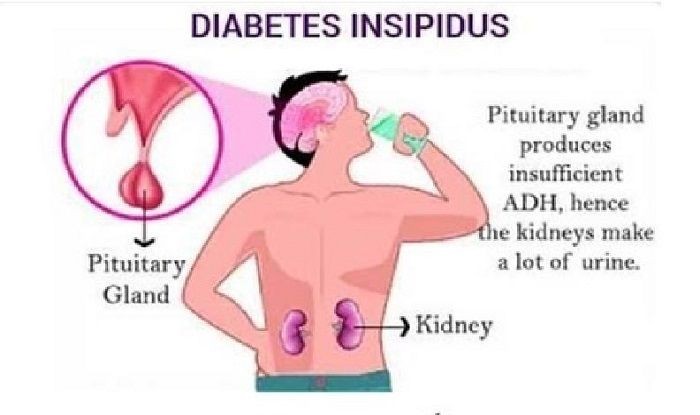ABOUT Diabetes Insipidus - Symptoms, Causes, Diagnosis, Prevention and Treatment
What is Diabetes Insipidus?
Diabetes insipidus is a chronic endocrine disorder that
affects the production of a hormone called vasopressin. It's caused by an
inability to concentrate the urine, and it's characterized by excessive daytime
urination and extreme thirst – or, in other words, constant dehydration.
Currently, there is no cure for diabetes insipidus –
but luckily there are two treatments available. The first treatment involves
fluid restriction to control the loss of fluids through urination. This often
helps patients to feel better and reduces their need for hospitalization.
Symptoms
All of these symptoms are caused by excessive
urination. When people with diabetes insipidus drink water, they urinate it out
again straight away – without even absorbing it into their bloodstream first.
This is why patients often feel thirsty, and this is also why they're
constantly urinating. It's not just urine volume that increases – it's also the
frequency of urination.
Causes
Diabetes insipidus can be caused by several different
things, which include:
·
Menopause – Many women will experience
post-menopausal excess production of vasopressin at some point in their life.
This is the most common cause of diabetes insipidus among older women.
·
Diabetes – Patients who have had type II
diabetes for a long time may experience a reduction in the amount of
vasopressin their body produces.
·
Physical head injuries – A head injury can
sometimes result in several different changes to the brain, and this includes
changes to the hypothalamus – an area associated with hormone production.
Diagnosis
The first step of diagnosis is generally a blood test,
which will be used to determine levels of vasopressin hormone present in your
bloodstream. If your levels are found to be significantly lower than normal,
then you're likely to be diagnosed with diabetes insipidus.
Treating diabetes insipidus is primarily focused on
controlling the loss of urine and electrolytes.
There are two main treatments for diabetes insipidus:
Fluid restriction and vasopressin administration.
·
Fluid restriction is the treatment that most
people with diabetes insipidus use, and it's based primarily on trial and
error. This treatment aims to control the loss of fluids through urination,
which can be done by restricting fluids in patients' diets. If fluids need to
be added back in, then the goal is to add in one gram of fluid for every 100 mg
of vasopressin in your body.
If fluid restriction doesn't work, then there is also
the option of administering vasopressin. This can be done in one of two ways:
·
Intravenous administration – This involves
injecting vasopressin directly into your bloodstream. It's the most effective
way of treating diabetes insipidus, but it's also the most invasive form of
treatment, so it's used as a last resort option. Most people with diabetes
insipidus will not receive this form of treatment because it requires
hospitalization and surgery.
· Vaginal administration – This is less invasive than intravenous administration, but it's not quite as effective. It is, however, the cheapest form of treatment.
Prevention
If you have diabetes insipidus, then it's important to
keep a close eye on your blood sugar levels. If you're diabetic, then your
blood sugar levels must be kept as low as possible – ideally below 7 mmol/L –
although below 5 mmol/L is often enough.
Treatment
In most cases, doctors will need to perform several
different tests to come up with a treatment plan.
Once a doctor has decided on the best course of action, patients usually start with a short period of fluid restriction. This involves limiting the amount of water you drink each day and is designed to increase the amount of water your body retains. The doctor will also want to organize further tests, such as an MRI scan and possibly an ultrasound scan. If your fluid levels don't improve after two weeks, then you may be asked to go to the hospital.
Frequently Asked Questions on Diabetes Insipidus
What are the symptoms of diabetes insipidus?
Patients with diabetes insipidus usually experience
excessive urination. This is the most common symptom, but it's not the only
one. Many patients also experience severe thirst, dry mouth, constipation,
fatigue, and lethargy.
What causes diabetes insipidus?
There are several different causes of diabetes
insipidus, but they have in common a reduction in the amount of vasopressin
hormone in people's bloodstreams. It's possible that menopause can also be a
cause of diabetes insipidus in women.

